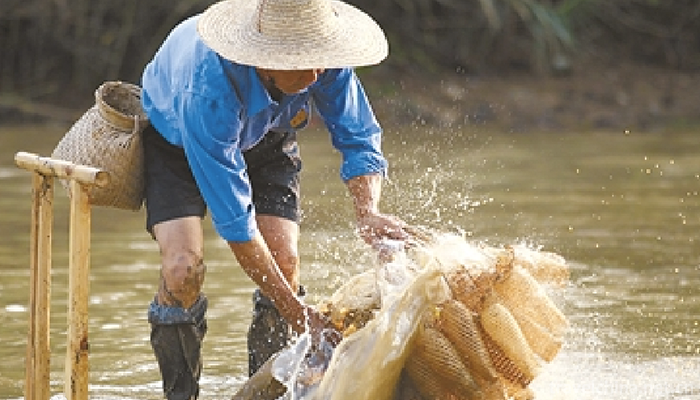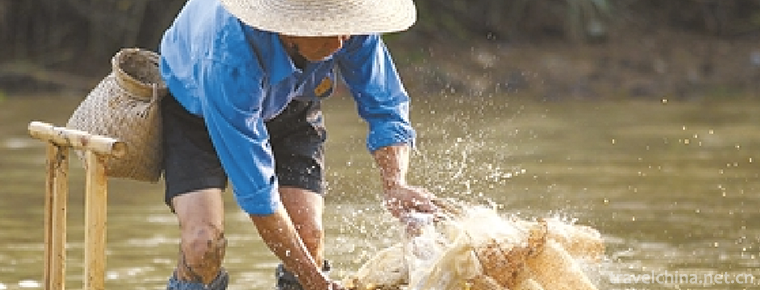Custom of mud fish
Custom of mud fish
The custom of filling mud fish is a local traditional handicraft with a long history in Guangdong Province. It combines traditional handicraft weaving and fishing skills. However, even in Doumen, the birthplace of "mud fish", fewer and fewer people know about "mud fish" now. At present, the villagers of "mud fish" in Qianwu Town are mainly middle-aged men over 40 years old, and they are facing the situation of few successors.
On May 23, 2011, the mud fish custom was approved by the State Council to be included in the third batch of national intangible cultural heritage list.
A Brief Introduction to Customs
This local traditional handicraft technique originated in the 30 years of Qianlong reign of Qing Dynasty (1765). Because of its smooth skin, mud fish often jump or crawl on shallow beaches, and it is difficult to catch it by bare hands. Villagers, according to the habit of mud fish appearing in mud caves, have worked out a way to trap mud fish in cages, while "trapping" is in Guangdong. In words, it means "trapping".
In Volume XIV of Xiangshan County Chronicle published in 1873, Tongzhi of Qing Dynasty described the unknown fish: "Ballistic drift fish is field drift fish, a flower fish and a seven-star fish. Grey and black, three or four inches long, with flowers, tender meat, delicious taste, can be used as soup. Because of their long-term activities on the beach, the surface color of the flower fish is similar to that of the sea mud, so the villagers in Hushan Village of Qianwu Town are accustomed to calling the flower fish "mud fish". The market price of mud fish is about 110 yuan/kg, which has high economic value.
According to the Propaganda Department of Doumen District, Zhuhai, the traditional custom of "filling mud fish" with a history of more than 240 years has recently been officially selected as a national intangible cultural heritage. Doumen District will protect the traditional skills that are on the verge of being lost through the establishment of an ecological protection zone for mud fish.
Custom Origin
The sun was scorching and the sea breeze was blowing. Dozens of figures wearing hats and treading mud boards swam through the offshore shoals and were cut into long and narrow silhouettes by the setting sun. The custom of "filling mud fish" originated in Qianwu Town, Doumen District, is a local traditional fishery production custom which integrates manual preparation and fishing technology. It has a very local characteristics and has been spreading for more than 200 years. This custom has been officially listed as the third national intangible cultural heritage list.
At first, it was fishing, but no suitable bait was found. Later, according to the habit of mud fish appearing in mud caves, the ancestors of Hushan Village in Qianwu Town of Doumen District made a living by "filling mud fish". They trafficked a large number of fish to Zhongshan, Jiangmen, Xinhui, Taishan and other areas, which became a very important form of trade at that time. Until the middle of the last century, 90% of the rural households in Hushan village used the income from selling mud fish as their main source of income, and often went fishing in groups. So far, the local villagers have kindly called the vast beach "mud jam ten thousand" (Cantonese dialect, meaning banks on the beach). Current status of fish cages for "mud fish". The custom of "mud fish" is on the verge of being lost.
In order to weave fish cage, not only the material selection and process are exquisite, but also the knitter should have a set of skilled manual skills. Generally, fish cages are 18-20 cm long and 8 cm in diameter. Mud fish, also known as flower fish, generally grow in the coastal area of Dongguan, Guangdong Province, while "dressing" mud fish is a unique fishing method in Dongguan, Guangdong dialect, "dressing" means "trapping". Because the skin of mud fish is very smooth, often jumping or crawling on the shoal, it is difficult to catch them by bare hands. Villagers like to catch mud fish in Dongguan. The habit of appearing in mud caves has worked out the method of trapping with cages. The special mud fish cage is equipped with an organ device, with a ring of toothed concealer, which extends inward like a funnel. When mud fish enter the cage by mistake, how cunning and clever they can not escape.
With the further acceleration of urban industrialization and the popularization of artificial breeding mud fish technology, the custom of mud fish has gradually disappeared. Zhangpeng Village staff said: "Before, many people in Zhangpeng could load mud fish, and when they were young, they also used to load mud fish with adults. Now, except Xinsha and Jiaowei two natural villages, a few of them are now carrying mud fish. The farmer who lives by fishing hardly sees villagers loading mud fish again.


-
1.Three Water Lotus World
Foshan Sanshui lotus world is the largest lotus scenic spot in the world with the richest variety resources. It integrates architecture, sculpture, Dutch, mobile games, hotels and catering
Time 2018-12-18 -
2.The Grand View Garden Area of Shanghai
Shanghai Grand View Garden is located at 701 Qingshang Highway, Qingpu District, Shanghai. It is situated on the west side of Dianshan Lake, 65 kilometers away from downtown Shanghai.
Time 2018-12-19 -
3.Seoul Lake Park
Seoul Lake Park is located in Weiyang District of Xi'an City, Shaanxi Province. It is 200 meters west of the cross of Fengcheng 4th Road and Zhuhong Road. It was originally the Unity Reservoir
Time 2019-01-13 -
4.Tianzhu Mountain National Forest Park
Tianzhushan National Forest Park, a national 4A-level tourist attraction, is located in Tianzhushan Town, 30 kilometers southeast of Shanyang County Town, Shaanxi Province, south of Huling and north o
Time 2019-02-22 -
5.Yongquan Qicheng Great Wall Ecological Scenic Area
The Great Wall of Yongquan Qi is a quiet tourist scenic spot, located in Yongquan Village, Zihe Town, Zibo City, where Pu Songling lived in the southeast mountain area. Here the mountains are connecte
Time 2019-03-05 -
6.Butterfly Bucket Encouragement of the Browns
Buzz drum dance is a kind of collective dance of men and women of ancestral origin. It has great improvisation. There are two kinds of dance methods: He Xinfang and
Time 2019-04-04 -
7.Bouyei Pange
Bouyei Pange is a traditional folk song of the Bouyei nationality. It is a folk literary work created and sung in the original Bouyei language. Bouyei Pange is popular in Buyi villages
Time 2019-04-04 -
8.The Art of the Peking Solo stringed Orchestra
The unique charm of the unique stringed instrument art of the Jing ethnic minority in China. It is a non-material cultural heritage project of the Beijing solo string art in Guangxi Zhuang Autonomous
Time 2019-05-07 -
9.Liao Zhais folk songs
The spreading area of Liaozhai slang mainly distributes in Zibo City, Shandong Province. The Pu family and its descendants are the main inheritors. Liaozhai slang is a unique traditional folk music li
Time 2019-05-13 -
10.Yibin Jiuzhou tower
Jiuzhou tower was built in the third year of Daguan in Northern Song Dynasty, that is, in 1109 ad, located in Yibin, Sichuan Province. The foot of the tower is 7.35 meters long from north to south
Time 2020-10-16 -
11.Location of Meishan
Meishan is located in the southwest of Chengdu Plain and the middle reaches of Minjiang River in Sichuan Basin. It spans 29 ° 24 ′ - 30 ° 16 ′ N and 102 ° 49 ′ - 104 ° 30 ′ e. it is 150 km long from east to west and 72 km wide from south to north. It connects Chengdu,
Time 2020-12-18 -
12.Meishan primary industry
In 2019, the total sown area of crops is 318000 hectares, an increase of 1.1%. Among them, the planting area of grain crops was 196000 hectares, an increase of 0.6%; the planting area of oil crops was 58000 hectares, an increase of 1.8%; the planting area
Time 2020-12-18